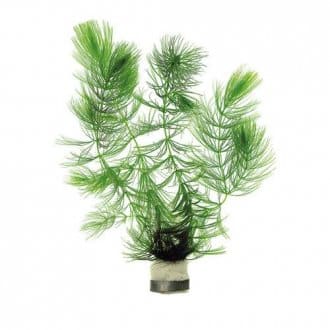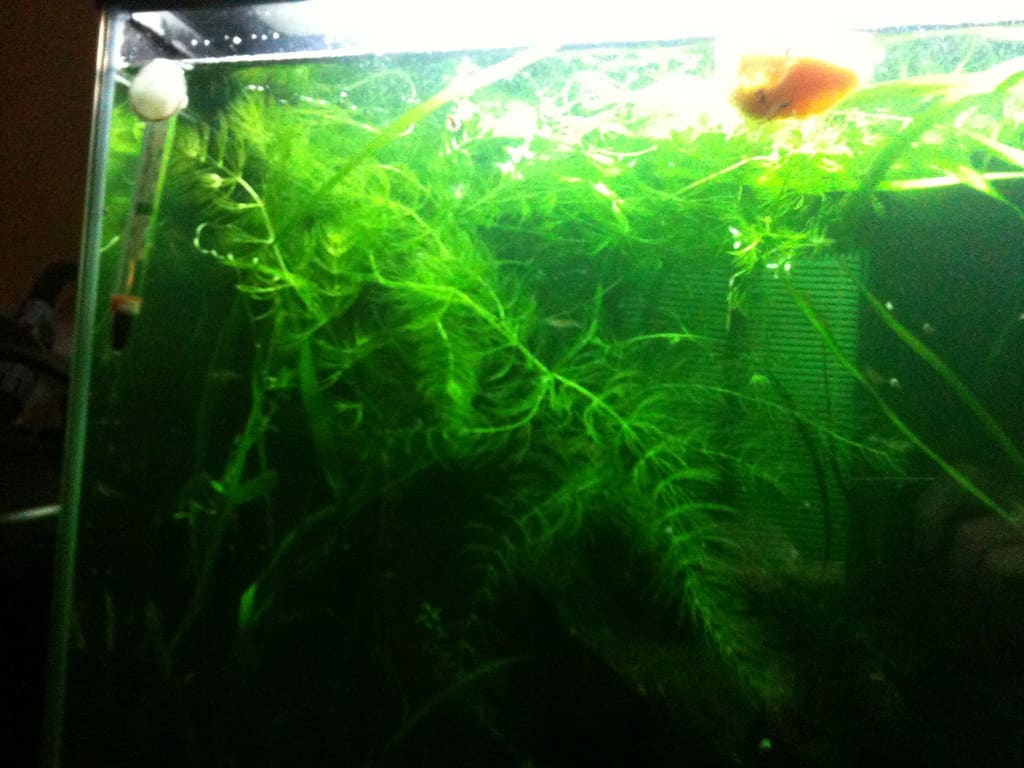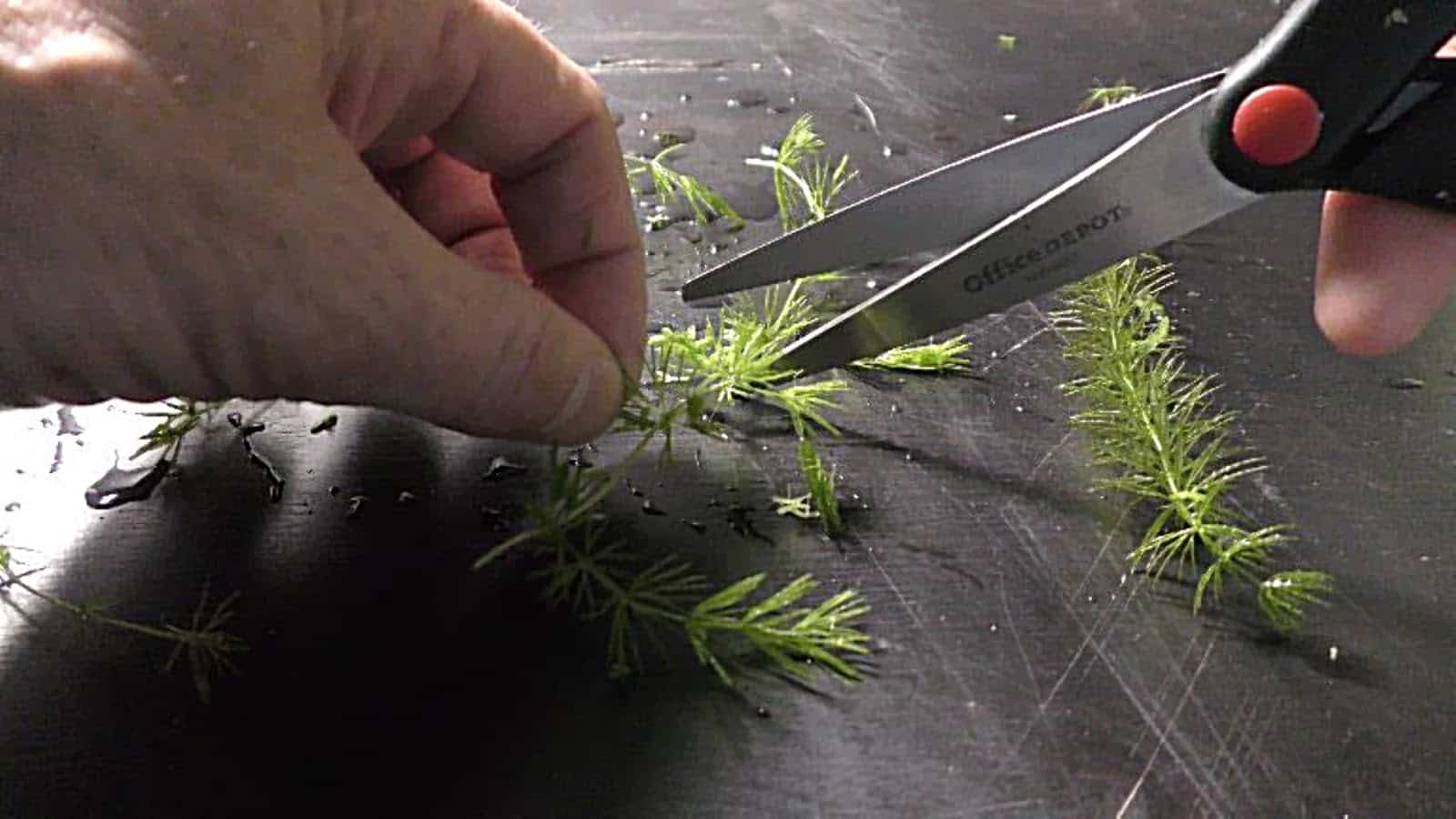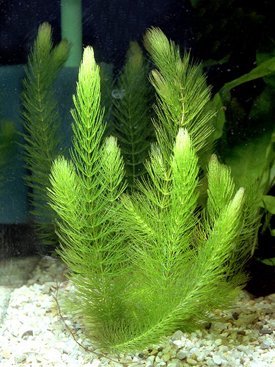Hornwort (ceratophyllum) is a popular aquarium plant. It is also known as Coon’s Tail – for the obvious reason that it looks a bit like the tail of a racoon.
Hornwort is a floating plant that does not put down roots, though it can be anchored down into the substrate of the tank with weights. Not to be confused with the Hornwort that grows on land, the water variety grows widely across the world in temperate regions including North America and the UK.
Hornwort grows in long strands of up to ten feet long, and has very dark green leaves that look like fronds along the length of the plant.
Hornwort in the wild
There are hundreds of types of hornwort, but the type most commonly found in aquariums is Ceratophyllum demersum.
Originally from north America, hornwort is now found in every continent except Antarctica. The plant grows in diverse environments, including rivers, marshes, lakes and ponds.
In some places, hornwort is considered to be a pest. It is classed as a weed in Australia and is an ‘unwanted organism’ in New Zealand. This is because the plant is so hardy, and grows so fast, that it can outcompete native species.
Appearance
A single hornwort plant can have several long stems. This can lead to the appearance of multiple plants, even when there is just one. Depending on how the stems are arranged, this can also give the plant a bushy appearance.

Hornwort can grow to be up to 10ft long, and grows incredibly quickly – up to 6 inches per week!
Along the stem, hornwort has groups of needles arrange in what are known as “whorls”.
Dictionary.com defines a whorle as “An arrangement of three or more appendages radiating in a circular or spiral arrangement from a point on a plant, as leaves around the node of a stem.”
The needles are short and stiff and grow in groups of six to twelve on each whorle.

Hornwort plants are generally dark green, though lowering light levels can cause the plant to become lighter green or even yellow.
Though you might not expect it, hornwort plants also have flowers. But don’t expect bright, colorful, pretty flowers. Hornwort flowers are small and green/brown in color. Each flower produce a very small nut.
Benefits of keeping hornwort in an aquarium
There are many benefits to keeping hornwort in your aquarium. Benefits of hornwort include:
- Oxygenated water: Plants release oxygen into the water as part of the photosynthesis process. This oxygen can then be used by your fish to breathe!
- Takes in waste: Hornwort soaks up nitrates, resulting in cleaner, better quality water and fewer ammonia spikes.
- Provides shelter: The plant is a great choice for fish that like somewhere to hide. A great example of this is fry – baby fish that need to hide from predators.
- Can be planted or float: Hornwort doesn’t have roots so it doesn’t need substrate. The plant can either be weighed down or left to float freely.
- Adds decoration: Hornwort isn’t the prettiest plant, but it does still add a bit of decoration and interest to the aquarium. This is particularly true when hornwort floats at the surface, as this is often a neglected area of the tank.
- A great background plant: When anchored to the floor of the tank, rather than left to float, hornwort can form a great backdrop for your fish.
- Easy to care for: Hornwort grows very easily and is very hardy. It’s therefore a fantastic plant for beginners
- Cheap: It costs less than $10 for a decent sized bunch of hornwort. And you don’t need to buy much, as it grows so quickly.
- Can help stop algae growth: Hornwort is “alleopathic”, which means it releases chemicals that inhibit the growth of other plants (of course, this is not always a benefit!)
Caring for hornwort
Hornwort is very easy to care for, with no extra CO2, fertilizers or complex additives or processes needed.
Tank conditions
Hornwort grows well in temperatures ranging from 59-86 F, while a pH of 6 – 7.5 and a GH of 5 – 15 is ideal. When kept in a pond, you may notice your hornwort dropping to the bottom of the pond in winter to protect itself from the cold.
Hornwort can be kept in a tank of any size, though the plant’s quick growth means it can quickly overrun small tanks. We therefore recommend a minimum tank size of 20 gallons. This is also our recommended minimum tank size for a single fancy goldfish. Of course, hornwort also does well in ponds.
Be very careful not to place hornwort near your filter, as debris such as needles and pieces of stem could easily block the water intake. You should also check that the flow of your filter isn’t too strong. Hornwort does best in still or slow-moving water.
The importance of light
As a plant that photosynthesises, hornwort needs light. We recommend moderate light levels – a single hood light for no more than 8 hours in any 24 hour period, for example – in order to keep the plant’s growth rate under control.
It’s important to check that your water is clear enough for the light to reach the plant. If you notice your hornwort turning yellow or growing slowly, it isn’t getting enough light.
If you provide too much light, your hornwort will grow quickly. This might sound good, but the plant will be thin – which doesn’t look as good – and it could overrun your tank. The more light, and the higher the temperature, the faster hornwort will grow.

Controlling growth
To keep the plant’s growth under control, you can trim hornwort when the stems reach the length that you want. Just be sure to trim from the top. You may also need to remove stems, removing the more yellow ones and keeping the greener ones.
Finally, it’s worth noting that hornwort will gobble up a lot of nutrients from the tank. This is great for keeping your nitrate levels down, but not so good for other plants. If you’re keeping other plants with hornwort, you may want to consider adding fertilizer for them.
Otherwise, Hornwort has no special requirements that you won’t already be providing for your goldfish. For example, regular water changes and a filter to keep the water clean.
Should you plant or float hornwort?
Whether to plant your hornwort or let it float freely is largely an aesthetic choice. Hornwort can grow either while weighed down or free floating, so it’s a case of whichever you think looks best. There are a few other factors to consider though.
Reasons to weigh hornwort down:
- If left floating, the hornwort is free to move around the tank. This may be undesirable as you won’t be able to choose its exact position.
- Hornwort that is floating around the tank sheds more needles, increasing debris that can make your tank look messy and clog up your filter.

Reasons to let hornwort float:
- The process of planting hornwort in substrate often kills the lower part of the plant, which causes the stem to snap and the rest of the stem to float freely. Even if you tie the plant down, the stem will often break. Getting hornwort to stay in one place can therefore be a constant battle!
- While hornwort can actually take root, this causes the stem to lose its needles near its base, which doesn’t look good.
- Goldfish often like to dig in the substrate and will deliberately dig up your carefully placed plants.

You might also want to think about where your fish swim. If you have surface swimming fish, put the plant at a lower level to add interest deeper in the water. Equally, if your fish swim lower down, hornwort can add interest near the surface.
Finally, here’s an interesting fact for you: As hornwort is free floating – so doesn’t need a substrate, such as soil – the plant has been used as part of biological life support systems on space missions!
Compatibility
Hornwort is compatible with all types of fish, including goldfish.
Goldfish love to rest among the shady leaves of the plant, and will generally not snack on it to a great extent. Goldfish will nibble hornwort, but they usually like to eat it less than they eat other plants. It’s also capable of growing quickly enough to survive even the greediest goldfish! Hornwort is also very good for controlling algae in goldfish tanks.
It’s also a great plant to keep with livebearers, as it provides their young with a place to hide from predators (sometimes including their own parents!).
Propagation
Hornwort spreads via “vegetative propagation”. This means that parts of the plant break off to form new plants.
If you want to help this process along, you can cut off a stem of hornwort. Simply choose a stem that is a healthy green color and a few inches long and cut it with scissors. The stem should grow into a separate plant.

Hornwort can also form turions, buds that sink in autumn and grow into new plants in the spring. You may see this process happening in a pond, but it is less likely to happen inside a goldfish tank.
Potential problems
Though hornwort is a very easy to care for plant, there are still some potential problems to be aware of.
- Growing out of control: Hornwort will grow as long as light and nutrients are available. To stop the plant getting out of control, be sure to cut the tops of stems regularly and remove any unwanted stems.
- Blocking light: Hornwort can grow to cover the tank or pond surface, preventing much-needed light from reaching other plants and fish. As above, you should trim your hornwort to ensure this doesn’t happen.
- Sharp needles: Hornwort needles are stiff and a little bit sharp. They’re unlikely to hurt a goldfish, but be extra careful when keeping hornwort with bubble eyes.
- Debris: Hornwort sheds its needles like a Christmas tree! This produces lots of debris that will need to be cleaned out of the tank on a regular basis. Needless to say, this can become a bit of a chore! Needle shedding is worse at higher temperatures.
- Lack of light: Some tanks, particularly those with a small surface area, may not allow enough light to reach the hornwort. If this happens the hornwort stems that aren’t getting enough light will begin to wither and die.
- Fast currents: Quickly flowing water can cause hornwort to float rapidly around the tank. This makes the hornwort shed its needles even more quickly than usual, which creates even more debris. One trick to avoid this problem is to buy some clear tubing and use this to “anchor” floating hornwort into a particular area of the water’s surface.
